On Wednesday, Oct. 29, the M. Rosetta Hunter Gallery hosted an hour of “Advice for Artists & Other Dreamers,” a conversation with Negarra A. Kudumu, an independent scholar and contemporary art curator. With extensive curatorial expertise, including the 25th Anniversary Neddy Award Exhibition in Seattle, a group exhibition at the ARCO Madrid art fair for the Lisbon-based art gallery MOVART, and three exhibitions during her tenure as curator at the Center on Contemporary Art in Seattle (CoCA), Kudumu walked into the gallery carrying a bag of Doritos chips and plenty of in-depth answers about the world of art, curation, and practical advice for aspiring artists.
After settling into the room, sitting in front of the colorful floor-to-ceiling installation “Andy’s Ambition” by Jane Richlovsky, Kudumu stood up from her seat and walked across the gallery towards a textile piece on the center of the main wall, “Wrapper” by Sheila Klein, and took a brief moment to observe the work. As students and workers gathered for the discussion, the conversation began around art as a physical experience.
When presented with an array of artwork, individuals subconsciously seek a focal point–often what’s most appealing, most recognizable, or in many cases, the “most aggressive to the eye,” Kudumu explained. However, rather than the mental processing of the visuals, Kudumu remarked that oftentimes, it is the “physical, visceral experience” that leads humans to love or hate a work of art. “That’s how I walk my own self,” she continued, “What grabbed my attention was this piece to the left of the screen here, which is why, at a certain point, you saw me get up and walk around so I could see it closer,” explaining that even though she was focused enough not to immediately walk over to the piece, “it was poignant enough for me to want to go back and look at it.”
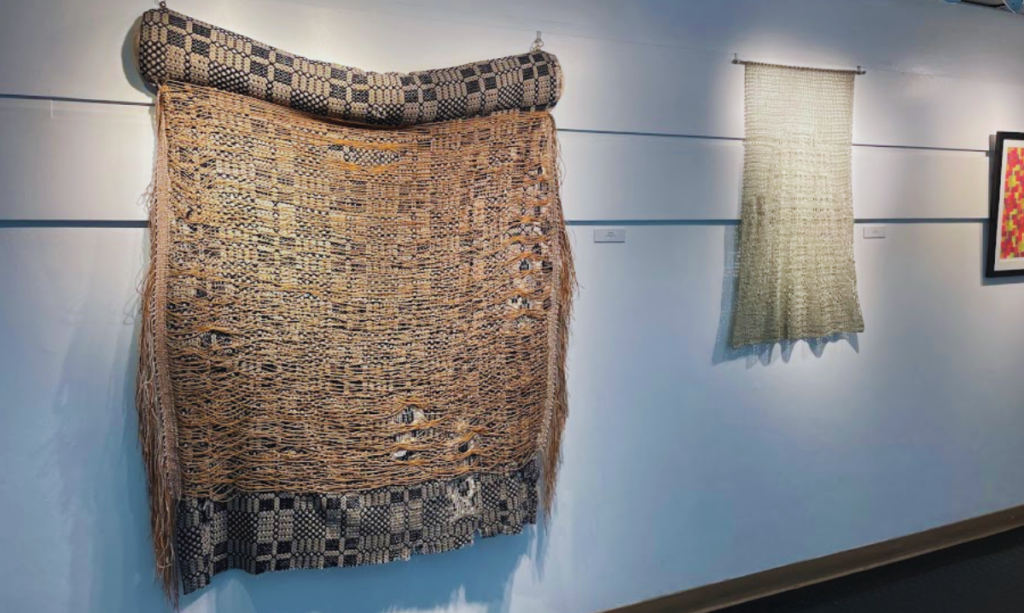
For Kudumu, that is a sign of both the quality of the artwork and great curatorial practice. “In my opinion, [curation] at its best tells a story that you can more or less follow, and that whether or not you agree with it, there are instances in which curators are intentionally attempting to create a jarring experience,” she said, adding that her experience of walking into “The Grid,” the show at the M. Rosetta Hunter Gallery during her talk, was successfully shaped by Meghan Trainor’s strategic curation of the exhibit.
The role of a curator starts with a notion of care for both the artwork and its context. The anglophone word derives from the Latin verb curare, meaning “to heal, to care for.” With the idea that a curator tells a story, Kudumu noted that “There was a time in the history of modern institutional curators, typically museums, where curators were exclusively scholars, and were required to publish, similar to what you still see happening in solely academic roles,” but that for a number of reasons, including the internet and access to funding, many museums have significantly cut back on publication. As a result, “There are quite a few curators who are not practiced writers,” Kudumu added, explaining it is unfortunate to artists, especially those who are emerging. “In addition to the exhibition, the importance of being published is really primary,” she continued, “This is how individuals know who you are months and years after the exhibition.”
Permanence is a crucial aspect of art. “Even memories fade,” said Kudumu, emphasizing the importance of physical records in the art world, “whether it’s a small pamphlet, a thick tone of 10 essays, or an exhibition catalog.” In a time where attention spans “are trashed—mine included,” she said, “the internet cannot be trusted to hold on to archives. I’m always going to be an advocate for printed matter,” Kudumu completed.
Writing and publication within the art world serve a greater purpose. “You now can have access to an artist that to you is obscure, but may actually be thinking on the same wavelength that you’re thinking, or may not. And that contradiction serves you in some way in your thinking about your practice,” Kudumu brilliantly remarked, portraying the purpose of storytelling, inherent to the human species, and its ever-lasting connection to growth and progress.
M. Rosetta Hunter Gallery’s Curator, Meghan Trainor, added that the idea of permanence applies to the artwork itself, within its construction and conservation, “they’re constructed in such a way that they will last for a long time,” Trainor said, illustrating that the practice starts from the very materials used by artists, such as utilizing acid-free paper and proper archival techniques. “An archaeologist is someone who is mining for the archives of yester century,” Kudumu said, comparing the profession to archival practices in the arts, “…And what they find literally is an archive that tells us something about that time.”
But at times, there’s nothing wrong with the inability to preserve a work of art as it once was. Sometimes, that is part of the artwork itself. “In performance art, an artist can do a performance of the same work [several times], and at different venues, but it’s going to have a different energy every time,” Kudumu explained. “The only people who will have memory of that experience are the people who were [there] at that particular moment in time, and there’s nothing wrong with it.” As a writer herself, Kudumu shared that writing, for her, is a level of permanence. “I do think there’s a place where one’s memories are valid, the recounting of these experiences,” she continued, saying that those memories are brought to the surface “the minute [they’re] down on the page.”
Continuing the conversation around permanence and exposure, another important factor for emerging artists is community. Though isolation seems to be a common desire among artists, especially in order to create, Kudumu noted that in terms of career support, “You do really have to engage in the community … To think about ‘who is my audience?’, ‘who are my peers?’ … Colleagues who work in different aspects of the art world, who have really interesting ideas and opinions that I find to be super useful.” Kudumu added that she has “work to do, things to think about, things to write, work to curate,” because she has “friends who are artists who have seen what I’ve been doing and the advocacy [for it]. Like, that’s how I got all my work.” She continued by saying that advocacy “goes both ways” and that “it could contribute to a healthy community of intellectual sharing and idea-generation. … It has been my community of artists and other folks who have propped me up in very important ways.”
Within Kudumu’s scholarly interests are African Diasporic spiritual traditions of the Americas, specifically Palo Monte and Conjure, which both emphasize the importance of vitality for individual and communal well-being and brought to the Americas through slavery. “When these individuals were enslaved, taken from their home territories, and brought to the United States, the elephant in the room was the fact that slavery compromised vitality,” Kudumu said, further exploring the profound importance of community in human nature. “A human cannot work at their optimum and thus be a generative community member, which would then allow the community to work at its optimum, if their vitality is compromised in any way.”
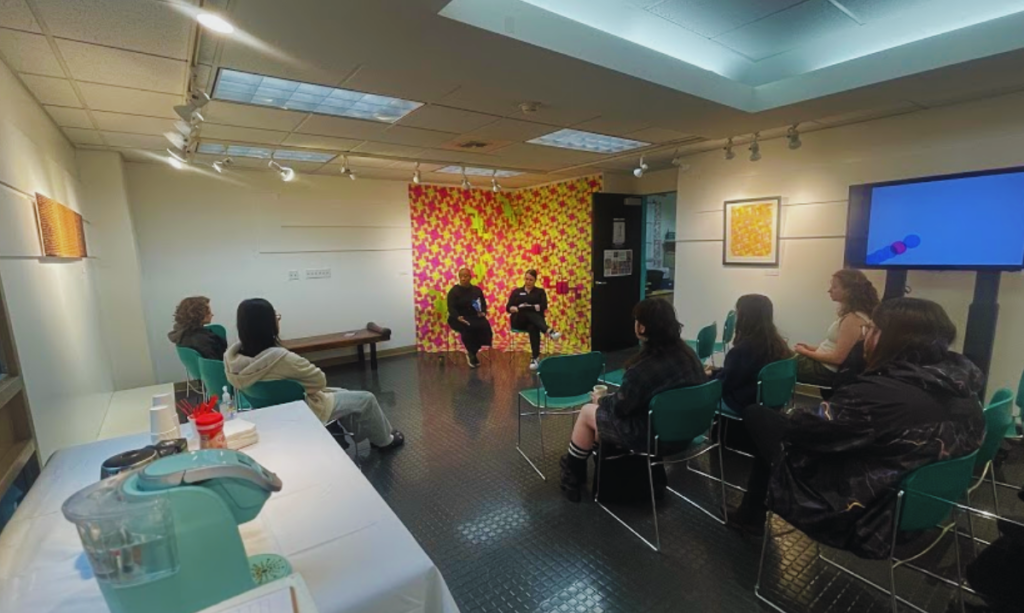
In order to “get their vitality back, they had to return to their spiritual traditions,” she continued, “but in the conditions they were living in, not the conditions they came from but the conditions they found themselves in [in] Cuba and in the United States.” For Kudumu, those are foundational principles, “I have seen the ways in which compromised vitality has wreaked havoc in my own life and my family’s life, but also in the lives of clients that I have had, people who are not a part of these traditions, people who have no intention of being a part of these traditions,” highlighting how the practice has influenced her personally and in her work with others, all under the larger idea of community.
Lastly, in the metalinguistic depth of the discussion, students were invited to participate by asking questions of multiple natures. The event came to a closure with Trainor’s announcement of the upcoming 2025 Seattle Central Student Invitational exhibit taking place during Spring quarter. The annual exhibition, previously juried by Negarra A. Kudumu in 2022, is an invitation for students to submit their artwork and engage with practical aspects of the art world, including community, exposure, and even permanence.
Author
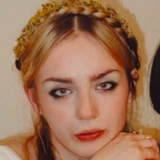
Sophia is an internationally published author with her book Primeira Pessoa, as well as a young classical singer. Born and raised in Brazil, she believes the greatest role of a writer is to bring forth the truth, the honesty, and the humanity that echoes within each one of us.


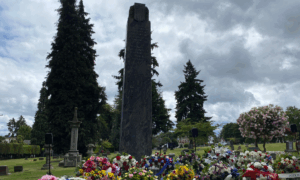

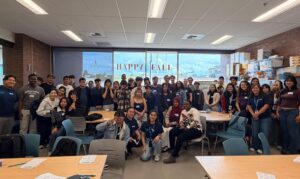

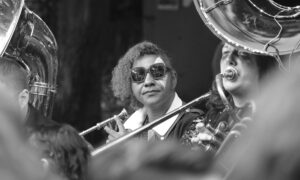

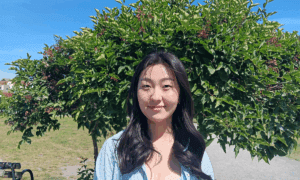

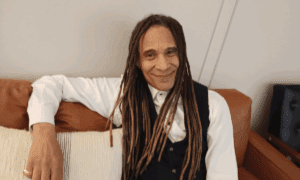
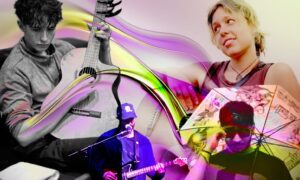
Be First to Comment